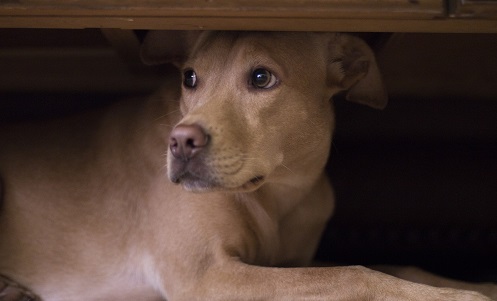For most dogs, the opportunity to go outside is the most fabulous treat in the world. There are so many beautiful stimuli outside for your dog to engage with, and as an added bonus, the outdoors allow your dog to explore and learn about the world they live in. Unfortunately, as much as your dog is prone to having a great time outside, they are also prone to potentially traumatizing experiences as well. While typically the outdoors offers a welcoming and fun environment for your dog, there are circumstances in which you could find your dog being afraid to go outside. If your dog is scared to go outside, this blog post is for you.
Common Reasons Your Dog is Scared to Go Outdoors
The first step in addressing your dog’s fear of the outdoors is addressing the root of the fear. Whether new founded or long-standing, if your dog is afraid to go outside, there must be a specific reason for it. Fear of the outdoors that comes on all of a sudden is most likely attributed to a change in circumstance or environment. Long-standing fears of the outdoors are likely trauma based and are more common in older rescue dogs. Puppies can be fearful of the outdoors, but this is typically a symptom of being unfamiliar with an outdoor environment, and a little supervised exploration generally is enough to overcome any hesitation a puppy may have.
 Your dog has a great memory, and unfortunately, negative memories leave a significant impact. While your dog may be fuzzy on the exact details of what it is that scared him, the fear can linger and cause a more deep-seated emotion. What may have seemed like a small encounter from your perspective could be a traumatic experience for your dog. Typically a dog will show fear or canine anxiety through verbal cues and body language. Noises like whimpering, growling, or dog crying generally indicates that your dog is anxious and on high alert. Physically your dog will show fear and anxiety by tucking his tail between his legs and lying down. Some dogs shake or tremble to show that they are nervous or scared. Take notice of when and where your dog exhibits these behaviors and take time to identify what the source of fear may be in and around that area.
Your dog has a great memory, and unfortunately, negative memories leave a significant impact. While your dog may be fuzzy on the exact details of what it is that scared him, the fear can linger and cause a more deep-seated emotion. What may have seemed like a small encounter from your perspective could be a traumatic experience for your dog. Typically a dog will show fear or canine anxiety through verbal cues and body language. Noises like whimpering, growling, or dog crying generally indicates that your dog is anxious and on high alert. Physically your dog will show fear and anxiety by tucking his tail between his legs and lying down. Some dogs shake or tremble to show that they are nervous or scared. Take notice of when and where your dog exhibits these behaviors and take time to identify what the source of fear may be in and around that area.
To combat a dog’s fear of the outdoors, an owner must implement counter conditioning wherein they slowly reintroduce their dog to a particular environment. In the case of the outdoors, reintroduction may start with bringing something from the outdoors inside, like a branch or a flower. Your dog’s greatest sense is the sense of smell, and reintroducing different scents is a great springboard for counter conditioning. After you familiarize your dog with certain scents, you can begin to slowly reintroduce your dog to that environment physically. Inviting your dog with you to come outside for short periods is a great way to slowly reintroduce them to the environment they showed fear of.
Never force your dog into a situation. Reintroduction to the outside should happen slowly and with patience. A good practice is to use treats to reward your dog for being outside. If a dog is only mildly afraid of the outside, take short walks, and every couple of minutes reward your dog with a treat. If your dog is afraid even to step outside of your door, try the same technique but this time stand just outside the threshold of your door and invite your dog to come out. With every step the dog takes toward you, reward the behavior with a treat and a positive verbal cue. Over several training sessions, your dog will begin to associate the treat with a movement toward, and being outside. Creating positive connections to the outdoors using counter conditioning overwrites a previously negative opinion about a certain place and gives your dog the confidence to be back outside.
 Dogs are bold, but certain things about the outside world can cause a canine to become frightened. Loud noises are at the top of the list for what can scare a dog. Thunderstorms, heavy machinery, fireworks; basically, any sound that is loud, sudden, and unexpected can be a trigger for your dog. Similarly, there are environmental triggers, like other animals or people, which can cause your dog pain or discomfort.
Dogs are bold, but certain things about the outside world can cause a canine to become frightened. Loud noises are at the top of the list for what can scare a dog. Thunderstorms, heavy machinery, fireworks; basically, any sound that is loud, sudden, and unexpected can be a trigger for your dog. Similarly, there are environmental triggers, like other animals or people, which can cause your dog pain or discomfort.
It is essential to follow the steps outlined above by eradicating the source of fear that triggered your dog and then implementing counter conditioning as a way to re-establish a positive connection to a specific environment. Because your dog can’t use words to tell you what he is afraid of, it is up to you as the owner to deduce and identify what could have made your dog frightened. With the use of positive counter conditioning and a little bit of patience, it won’t be long before your dog is ready to take on the world.
Sources:
Farricelli, Adrienne Janet. “Tips for Dogs Scared to Go Potty Outside.” PetHelpful, 24 May 2019, pethelpful.com/dogs/Tips-for-Dogs-Scared-to-Go-Potty-Outside
“Why Is My Dog Afraid to Go Outside?” PetMD, 11 Apr. 2018, www.petmd.com/dog/behavior/why-my-dog-afraid-go-outside.
Harleman, James. “5 Common Dog Fears and How to Help.” Rover, 27 Feb. 2019, www.rover.com/blog/common-dog-fears/.




